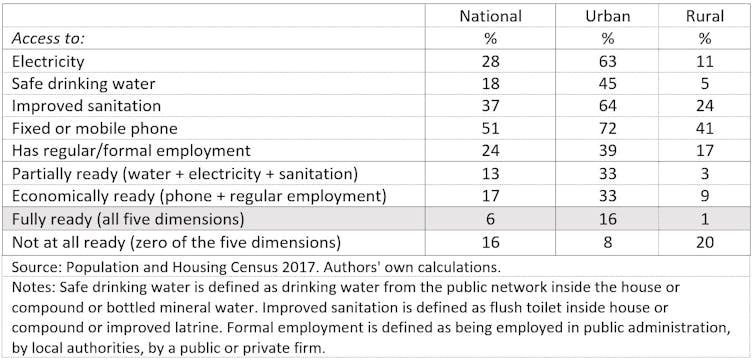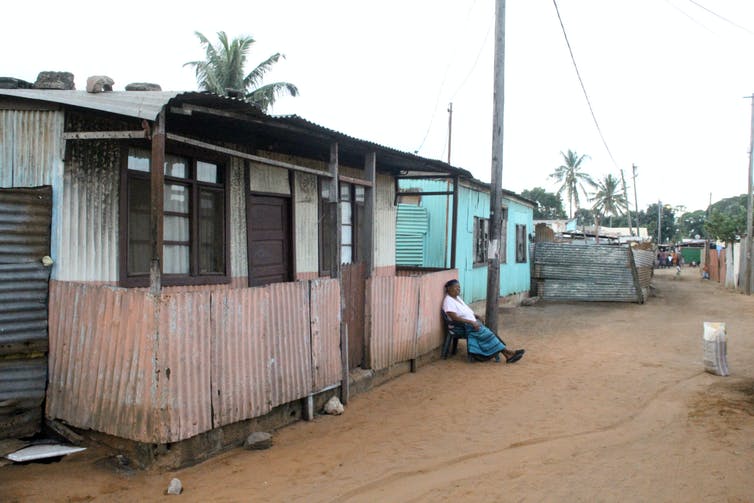By Sam Jones, United Nations University; Eva-Maria Egger, United Nations University, and Ricardo Santos, United Nations University
As the COVID-19 virus has spread across the globe, developing countries are starting to enact many of the same policies used in China, Europe and North America to contain the virus. But are these policies appropriate in low income contexts? To help think about this we propose a simple index of lockdown readiness which identifies the share of households that could feasibly shelter at home for a prolonged period of time.
Using Mozambique as a case study, our lockdown readiness index suggests a need for more inventive adaptation of public health policies, not blind adoption from elsewhere.
Many countries have introduced lockdown measures, including home isolation, as a response to the global pandemic. Such policies were originally adopted by China and, over the past months, have been replicated by governments in the global North.
The aim of home isolation is to maintain a maximum of social distancing to reduce contacts with non-family members to an absolute minimum. But this assumes families actually can stay isolated with relative ease. In the global North, for example, an underlying assumption is that many people can work remotely via the internet and phone.
But what are the conditions that make it feasible to shelter at home?
Applying the index to Mozambique our main takeaway is that a strict or full lockdown would be very difficult for a large share of households in Mozambique, including those in urban areas. It is not only that household conditions are often unsuited to a lockdown. Many people simply could not afford to stay at home.
Without a broad-based safety net in place, which could temporarily substitute for lost income opportunities or put enough food on the table, a strict lockdown could quickly degenerate into social unrest.
The five criteria low income countries must have in place for lockdowns to work
To make things simple, we consider the following five minimum criteria for a lockdown (often available in household surveys or census data):
- access to safe drinking water in the home;
- adequate sanitation in the home;
- a source of reliable energy;
- access to information or communications technology; and
- having a permanent source of income or savings.
If the first three criteria are not met, then almost all household members will need to make multiple daily trips outside the home to places where other people congregate. These include communal taps or ablution facilities.
But even if these basic household conditions are in place, this does not put food on the table. Families living from hand to mouth would still struggle to stay in lockdown. And as noted in other contexts, disobedience or social unrest can quickly follow if a lockdown drives people into despair.
As the decision to put an entire country or region in lockdown carries not only large economic costs but also social risks, policy makers need to consider whether such a policy is feasible. One way of doing so is through a lockdown readiness index. Using the above criteria, we constructed one for Mozambique.
Readiness reflects inequality
Based on the 10% sample of Mozambique’s 2017 housing and population census we consider the following five variables. Three are the same as in the first list – access to safe drinking water, adequate sanitation and electricity in the household. The other two we adapted to: having a phone in the household; and someone in the household having regular (formal) employment.
We define a household as “fully ready” if all five conditions are met and as “partially ready” if the first three of the five conditions are met – that is, they have the basic services to remain at home. The results are presented in the table below.
Table 1: Access to resources for lockdown readiness

According to our index, it would only be immediately feasible to lock down around 6% of all Mozambican households, corresponding to 16% of Mozambique’s urban households and just 1% of rural ones.
Overall, 13% of households would be partially ready, meaning they have access to basic services but probably not sufficient income or savings. In urban settlements, only a third of households (33%) are ready in terms of basic services. So, for them, a lockdown might be feasible for a short period of time but some additional social safety provisions would need to be enacted, such as cash or food transfers.
Looking across different regions of the country, the degree of readiness reflects levels of inequality found also in national poverty assessments. In the northern regions less than half the households show even partial readiness for a lockdown, while the south is the least deprived and thus most “ready” region. Yet, even in the capital city, Maputo, located in the south, less than 40% of the households are fully ready for a lockdown.
What are the alternatives to lockdown?
Rather than blindly replicating policies from higher income contexts, we recommend practical alternatives to a complete or general household lockdown.
While this must be designed locally, ideally with community engagement, part of such a package must involve extensive testing and tracking to identify virus hotspots, as in Vietnam, as well as extensive prevention measures. And even if a lighter form of lockdown must be enforced, large-scale social protection programs (such as cash transfers) and basic service expansion (such as mobile drinking water stations) would be required to avoid an even greater catastrophe.
Sam Jones, Research Fellow, World Institute for Development Economics Research (UNU-WIDER), United Nations University; Eva-Maria Egger, Research Fellow, World Institute for Development Economics Research, United Nations University, and Ricardo Santos, Research Fellow, World Institute for Development Economics Research, United Nations University
This article is republished from The Conversation under a Creative Commons license. Read the original article.
![]()
